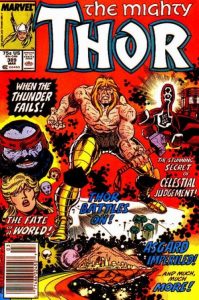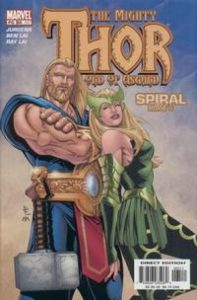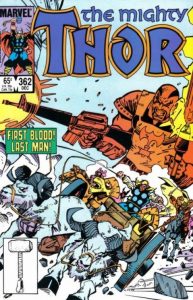Why? Well Webster defines a book as “a set of printed sheets of paper that are held together inside a cover.” These items are designed to hold and share information. You can buy 2, 3 or 100 copies of the same book and receive the same information.
So therefore, comic books are designed to share information through illustrated strips. You can buy 2, 3 or 100 copies of the same comic and receive the same information.
With this in mind, let me share with you 10 great comic book runs with phenomenal illustrated strips. Spoilers!
10. Thor Vikings #1-5 by Garth Ennis and Glenn Fabry.
a. Undead 100-year-old cursed Vikings return to present day and easily kick Thor’s butt. Only with the help of Dr. Strange and a few time-displaced relatives can they hope to defeat the uber violent Harald Jaekelsson. This is the Thor book for people that dislike Thor, sword and sorcery, or high fantasy books.
b. Preachertastic artwork.
9. Thor (2020) #9 to #14. By Donny Cates and Nic Klein
a. Odin created DR. Donald Blake to temper Thor’s hubris. Thor used to swap bodies and minds with Donald Blake. Thor stopped doing that for a long time as he never considered this. The Doctor is not happy about that once he finds out. Wonderful Geof Johnsonian twist on the Dr. Donald Blake & Thor relationship.
b. The next evolution of epic artwork.
8. Thor (1963) #387 to #389 by Tom Delfaco and Ron Frenz.
a. Having just had all wounds healed, Thor shaves. Thor keeps his awesome armor designed to fight Fin Fang Foom. Thor then fights a new Celestial. By himself. Nuff said.
b. Classic comic book artwork.

7. Journey Into Mystery (1963) #101 to Thor (1963) #179 by Stan Lee and Jack Kirby.
a. If I need to explain why a book by Jack Kirby is epic and great, etc. Then you probably enjoy collecting Momoko covers or watching paint dry.
b. The visual impetus for all modern comic book artwork.
6. Thor (2007) #1 to #6. By J Michael Straczynski and Olivier Coipel.
a. Thor finally returns after Marvel, Rob and Jim killed him. He returns again as the King of Asgard. Thor promptly puts New Asgard over Oklahoma and shows Tony Stark how pathetic he is.
b. Truly the first epic otherworldly Thor artwork.
5. Thor (1998) #43 to #79. By Dan Jurgens and Scott Eaton & others.
a. Odin dies (again) and for the first time Thor ascends to the Throne of Asgard. Thor loses his arm the first time! Thor loses his eye for the first time! Thor eventually takes over the world and spreads his religion on everyone even if the disagree. And he is still worthy to lift Mjolnir to many an enemy’s surprise!
b. Mostly great artwork from all styles of the late 90s.

4. Thor Son of Asgard #1-12. By Akira Yoshida and Greg Tocchini.
a. Some of the best Jack Kirby stories pre issue #101 were his Tales of Asgard backups featuring young Thor and Loki. This mesmerizing saga shows perfectly just how hard and why Thor needed to be worthy of not just Mjolnir but of being himself.
b. Breathtaking otherworldly artwork.
3. Thor God of Thunder (2012) #1 to #25. By Jason Aaron and Esad Ribic & others.
a. Three different timelines. Three very different Thors faceoff against Gorr the Godbutcher over the timespan of the universe. Gorr is easily the best new Thor villain in 20-30 years.
b. The return to epic artwork.
2. Thor #337 to #339. By Walter Simonson.
a. The groundbreaking, world shattering and arguably the first best in story, in continuity, in the regular series, replacement of a hero with a new version. Enter Beta Ray Bill. All hail Walter Simonson as he easily and deftly weaves actual Norse mythology and Marvel continuity into one great run.
b. The visual style that all Thor artwork before and after are compared too.
1. Thor #360 to #362. By Walter Simonson.
a. As great as the previous 20 plus issues of Simonson’s run were, I feel these 3 issues are the epitome of comic book greatness. Featuring my single most favorite single comic of all time, Thor #362. The only comic I have ever read more than three times and not to understand what happened. Just to bask in its awe-inspiring magnitude.
b. Artwork to bask in, unsurprisingly featuring my single favorite comic book page ever.

So why are comic book NFTs stupid? Best answer I have because I do not even understand NFTs.
Well, Webster defines stupid as “not intelligent: having or showing a lack of ability to learn and understand things.”
1. Anyone can find, read, and decide for themselves if these stories are worthy.
2. As I understand it, all NFTs are unique.
3. Thereby NFTs are not accessible to everyone.
4. And no two NFTs are the same.
5. So, in my mind NFT comic books are not true comic books at all.
6. They miss the point of comic books in their most basic function.
7. Kinda sounds like stupid to me.

